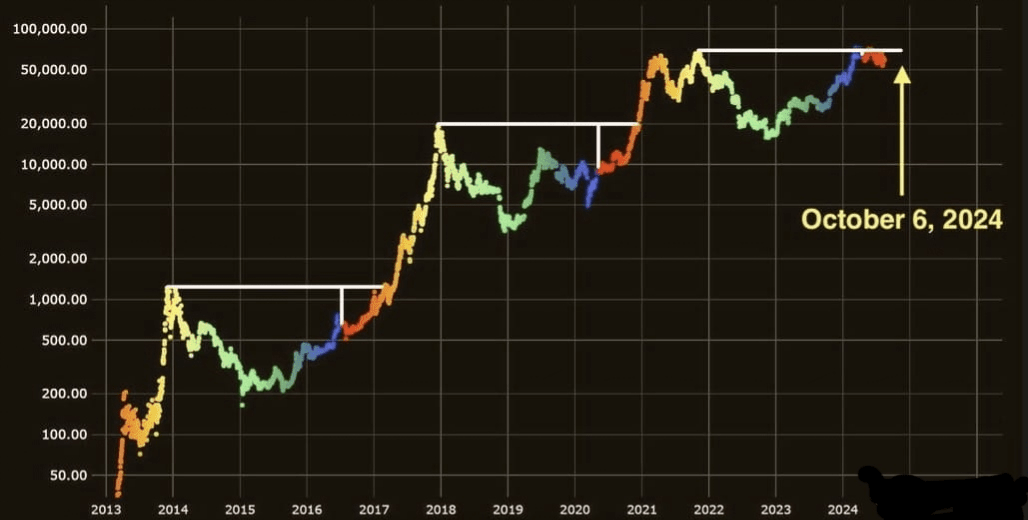Great bulls always start unknowingly and grow in hesitation!
After each halving, Bitcoin experiences an adjustment period of about 6 months.
In 2016, it took 170 days to break the previous high after the halving.
In 2020, it took 197 days after the halving to break the previous high and initiate a bull market.
As of now, 170 days have passed since this halving in 2024.
Short-term bullish signs: if Bitcoin breaks through $70,000 and stabilizes, it may announce the official start of a new round of market activity.
Currently, market sentiment is improving, with prices stabilizing at $62,000 and signs of upward movement, but seasoned investors unanimously believe that a true bull market only begins after breaking $73,000.
Based on historical cycle predictions, analyzing Bitcoin's halving cycle, the frenzy cycle after the halving starts 170 days post-halving. October 7, 2024, is this critical point, suggesting that a bull market may have already begun or is about to begin.

From the price chart, Bitcoin was hovering around $62,000 before October 7. After 8:30 AM on October 7, it indeed began a rally, breaking through $64,000 in less than an hour.
In the following days, it experienced a rapid pullback to around $59,000 to induce short selling, which is likely the last period below $60,000. Currently, it has stabilized again at $62,000.
Long-term bullish predictions suggest that the period between 2023 and 2024 is not a true bull market but rather a transition from bear to bull market, with the real bull market expected to arrive between 2025 and 2026.
This view suggests that Bitcoin's brief breakthrough of 2021's high is mainly due to the ETF applications, rather than a true bull market driver.
Moreover, some analysts believe that Bitcoin will reach $300,000 in 2025.
Technical analyst Tradingshot states that Bitcoin is approaching 'the starting point of the most aggressive positions in the historical bull market cycle' and predicts that by the end of 2025, Bitcoin's price could rise to $300,000. This price is a technical prediction as it measures the values from high to low when touching the MM (Mayer Multiple) mean.
Several factors support Bitcoin rising to $300,000.
1. China is printing $280 billion to boost the economy.
2. The Federal Reserve starts a series of interest rate cuts, and global central banks follow suit, leading to global monetary easing.
3. The Bank of Japan shifts to a dovish stance, halting interest rate hikes.
4. Trump leads again, if re-elected, it will be a catalyst to drive prices up to $300,000.
5. Bitcoin ETFs are starting to accumulate again, and more individuals and institutions will purchase Bitcoin through ETFs.
6. The amount of Bitcoin flowing to exchanges has dropped to very low levels, indicating weakened selling pressure.
7. The distribution of FTX's $16 billion is expected to take place this quarter, at which point many users will receive compensation and a large amount of funds will rush to purchase Bitcoin.
8. Russia plans to start using cryptocurrencies for cross-border settlements before November.
9. The global M2 money supply has reached $107 trillion, setting a new historical high.
10. The U.S.-China confrontation is vying for global funds, with A-shares and Bitcoin both soaring.
Let’s elaborate on two points: the U.S.-China competition for funding and interest rate cuts.
The U.S. interest rate cuts will cause hot money to flow out, so China quickly introduced a basket of stock market incentives including the test launch of Dongfeng 31 intercontinental missiles.
I elaborated earlier (the global shock, the Bitcoin financial nuclear bomb vs. the Dongfeng intercontinental nuclear bomb is the largest conspiracy we have seen in our lifetime), China hopes to attract hot money, but the U.S. definitely does not want money flowing into China, wishing for funds to remain in dollars and under American control.
Thus, the U.S. has a good option, which is cryptocurrencies. We know that cryptocurrencies are priced with an absolute advantage in dollars, and the U.S. has already legalized it through ETFs. However, if the crypto market does not have a profit effect, how could capital possibly flow in?
Therefore, the first step is to let the crypto market be profitable to intercept funds flowing into China as much as possible, and the top in China thinks the same, so ultimately we are likely to see both A-shares and Bitcoin take off together.
Regarding interest rate cuts and capital inflows, most analyses indicate that Bitcoin's response after the first rate cut will not be significant, but as multiple rate cuts occur, large funds may begin to accelerate their purchase of risk assets, predicting significant capital inflows this quarter.
The market has not yet fully reflected these positive factors due to the Middle East war. Once the market reacts, coupled with the U.S. elections in early November and the Fed's second round of interest rate cuts, Bitcoin will reach a new historical high, quickly hitting $100,000, and ultimately reaching $300,000 by 2025.
All information points to the possibility that a bull market may have already begun or is about to begin.

I am Xi Mo, a web3 evangelist dedicated to turning your main job into a side job and your side job into unemployment (financial freedom).
A year ago, we created a web3 private wealth reading for our paying students, titled 'Xi Mo's Crypto Perspectives,' which contains over 1,000 pages recording a 320,000-word collection on crypto wealth. Now I am giving it to you for free.
Click my avatar to receive a free electronic version of Xi Mo's crypto wealth perspectives.





